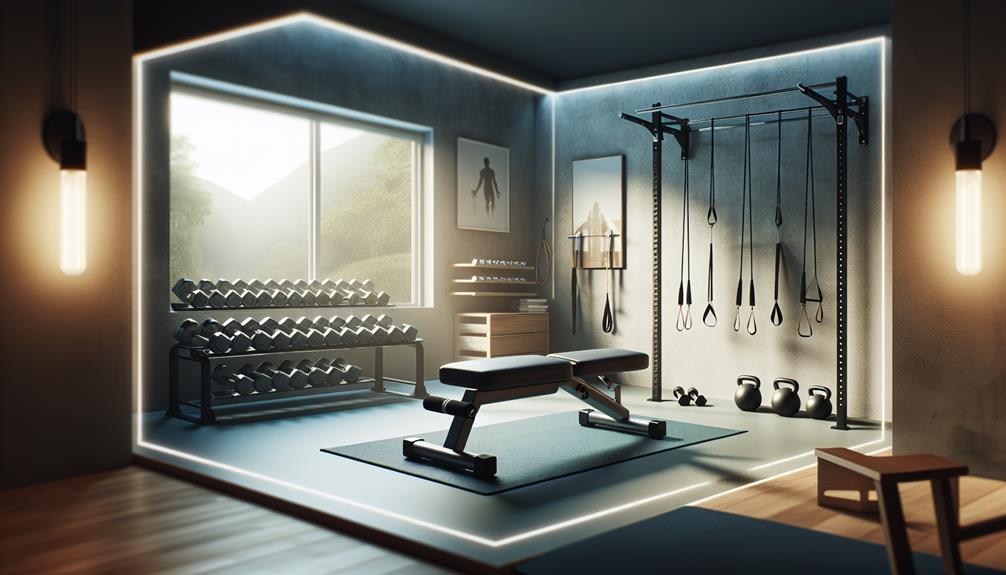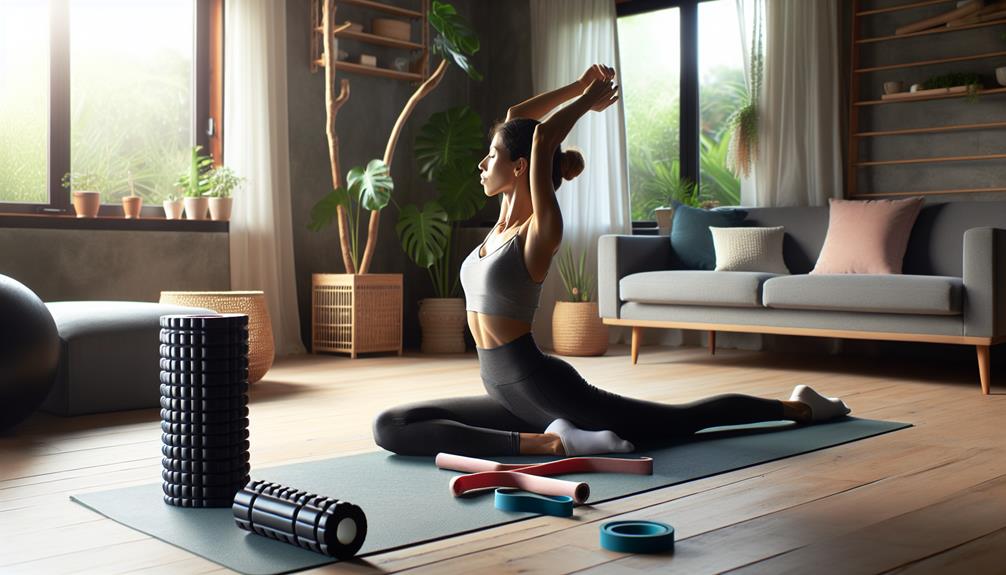Are you tired of spending a fortune on fancy gym equipment that ends up collecting dust in your basement? Well, fear not, because you can achieve a complete workout plan right in the comfort of your own home, without any extravagant equipment. With just a few essential items and a little creativity, you can transform any space into your very own home gym. But what are these essential items, you ask? Stick around, and we'll reveal all the secrets to building a home gym that will leave you feeling fit and fabulous.
Key Takeaways
- Dedicate a space in your home for workouts and ensure it is clear of hazards and obstacles.
- Incorporate resistance bands for added challenge and versatility in your home workouts.
- HIIT workouts are effective for burning calories and improving cardiovascular fitness.
- Use bodyweight exercises and modify them to match your fitness level for strength training without weights.
Essential Equipment for Home Workouts

To effectively engage in home workouts, you'll need essential equipment that can help you achieve your fitness goals. Creating a dedicated home workout space setup is crucial for maximizing your workout experience. Find an area in your home where you have enough space to move freely and comfortably. Clear the area of any potential hazards or obstacles that could interfere with your workout. Make sure you have proper lighting and ventilation to ensure a safe and comfortable environment.
When it comes to equipment, incorporating resistance bands can add an extra challenge to your workouts. Resistance bands are versatile and can target various muscle groups. They provide constant tension throughout the range of motion, helping to build strength and improve muscle definition. Additionally, they are lightweight, portable, and affordable, making them a great option for home workouts. You can use resistance bands for exercises such as bicep curls, squats, lunges, and shoulder presses.
Full-Body Cardio Exercises
Get your heart pumping and work your entire body with these full-body cardio exercises. When it comes to getting a good cardio workout at home, HIIT workouts and low impact exercises are great options. High-Intensity Interval Training (HIIT) workouts involve short bursts of intense exercise, followed by periods of rest or lower intensity. They are effective for burning calories, improving cardiovascular fitness, and increasing endurance. You can try exercises like jumping jacks, burpees, mountain climbers, or high knees to get your heart rate up and challenge your muscles.
For those looking for low impact options, there are plenty of exercises that provide an effective cardio workout without putting excessive strain on your joints. Walking or jogging in place, step-ups, or marching can all be done without any equipment and are gentle on the joints. Other low impact exercises include swimming, cycling, or using an elliptical machine if you have one at home.
Remember to always warm up before starting any cardio workout and cool down afterward. Start with shorter intervals and gradually increase the intensity and duration as your fitness level improves. With these full-body cardio exercises, you can get your heart rate up, burn calories, and work your entire body without fancy equipment.
Strength Training Without Weights
If you're ready to challenge your muscles and build strength without the use of weights, there are several effective exercises you can incorporate into your home gym routine. Resistance bands and bodyweight exercises are great alternatives that can help you tone and strengthen your muscles.
Resistance bands are versatile and affordable tools that can provide varying levels of resistance. You can use them to target different muscle groups, such as your arms, legs, and core. Bicep curls, tricep extensions, and squats with resistance bands can effectively engage your muscles and promote strength development.
Bodyweight exercises, on the other hand, rely solely on your body's weight for resistance. Exercises like push-ups, planks, and lunges can effectively work your upper body, core, and lower body muscles. These exercises can be modified to match your fitness level, making them suitable for beginners and experienced individuals alike.
Incorporating resistance bands and bodyweight exercises into your home gym routine can help you build strength and improve your overall fitness. They are convenient, require minimal equipment, and can be done in the comfort of your own home. So, challenge yourself and start incorporating these exercises into your workout routine today!
Core and Stability Exercises
Incorporating core and stability exercises into your home gym routine is essential for building a strong and balanced foundation. These exercises not only target your core muscles but also improve your overall stability and balance. Proper form is crucial when performing core exercises to maximize their effectiveness and prevent injury. By engaging your core muscles and maintaining the correct posture, you activate the deep muscles in your abdomen, back, and pelvis, which helps improve your overall strength and stability.
Stability exercises, on the other hand, focus on improving your balance and coordination. These exercises often involve unstable surfaces or equipment, challenging your body to maintain control and stability. By incorporating stability exercises into your workout routine, you enhance your body's ability to stabilize itself during daily activities and sports, reducing the risk of falls and injuries.
The benefits of incorporating core and stability exercises into your home gym routine are numerous. Not only do they help strengthen your core muscles and improve your stability, but they also contribute to better posture, reduced back pain, and enhanced athletic performance. So, make sure to include exercises like planks, bridges, Russian twists, and single-leg balance exercises in your home gym workouts to reap these benefits and build a strong and stable foundation for your fitness journey.
Recovery and Stretching Techniques

To effectively recover and improve flexibility after core and stability exercises, it is important to incorporate proper recovery and stretching techniques into your home gym routine. Here are four essential methods to help you recover and enhance your flexibility:
- Foam Rolling: Using a foam roller can help release muscle tension and tightness. Roll the foam roller over the targeted muscle group, applying pressure to trigger points for about 30 seconds to alleviate any soreness.
- Static Stretching: Perform static stretches after your workout to lengthen and relax your muscles. Hold each stretch for 15-30 seconds without bouncing or jerking. Focus on major muscle groups such as hamstrings, quadriceps, and calves.
- Active Recovery: Engage in light activities such as walking or cycling on your rest days. This helps increase blood flow to your muscles, promoting faster recovery and reducing muscle soreness.
- Yoga or Pilates: Incorporate yoga or Pilates into your routine to improve flexibility, strength, and balance. These exercises often combine stretching and strength training, making them ideal for recovery and flexibility enhancement.
Frequently Asked Questions
How Much Space Do I Need to Set up a Home Gym?
You'll need enough space to comfortably move around and store your equipment. Consider a room or area that's at least 100 square feet. This will give you enough room for various exercises and equipment.
Can I Achieve the Same Results With Home Workouts as I Would in a Traditional Gym?
You can definitely achieve the same results with home workouts as you would in a traditional gym. It's all about finding the right exercises, staying consistent, and pushing yourself to your limits. Don't underestimate the power of your own home gym!
Are Bodyweight Exercises Effective for Building Muscle?
Bodyweight exercises are effective for building muscle. They can replace traditional gym equipment for muscle building. Incorporating bodyweight workouts into your routine can yield results comparable to weightlifting, without the need for fancy equipment.
How Often Should I Do Cardio Workouts at Home?
You should aim to do cardio workouts at home regularly, like a well-oiled machine. The frequency depends on your fitness level and goals. Incorporate exercises like jumping jacks, running in place, or dancing to get your heart pumping.
What Are Some Recommended Recovery Techniques to Optimize the Benefits of Home Workouts?
To optimize the benefits of home workouts, incorporate recovery techniques like foam rolling and proper nutrition. Foam rolling helps with muscle soreness and improves flexibility, while proper nutrition provides the necessary nutrients for muscle repair and growth.
Conclusion
In summary, with these home gym essentials, you can create a complete workout plan without any fancy equipment. From full-body cardio exercises to strength training without weights, and core and stability exercises, you can achieve a well-rounded fitness routine. Don't forget to prioritize recovery and incorporate stretching techniques for optimal results. Get ready to embark on a practical and effective fitness journey right from the comfort of your own home.












